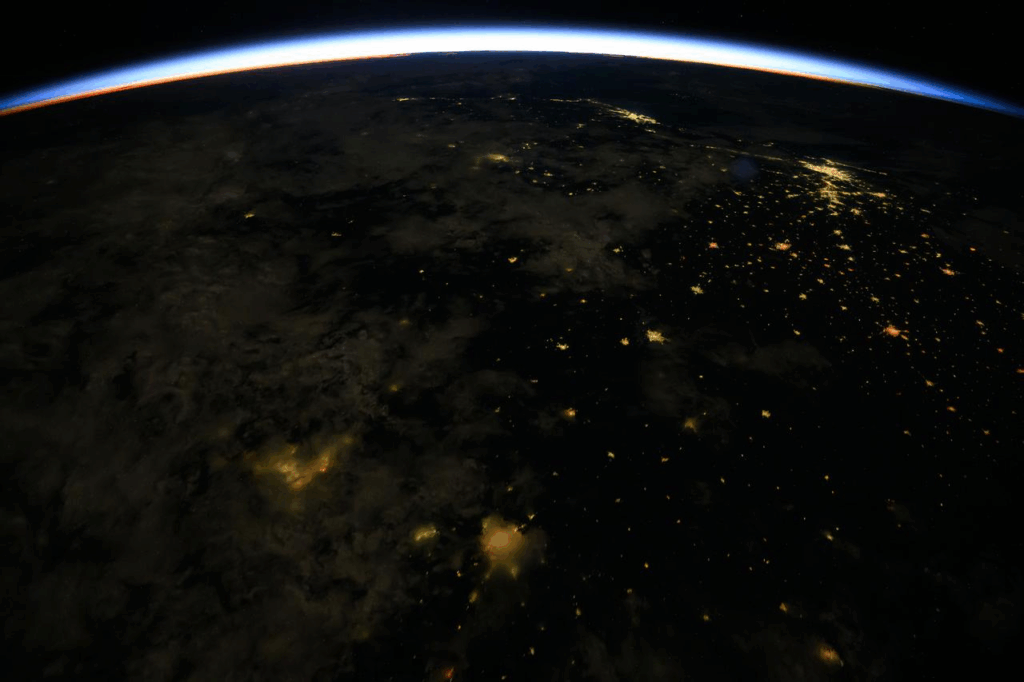I can’t even imagine what it must feel like. You are 420 kilometers above the earth and traveling at a speed of 28,000 kph. That’s over 22 times the speed of sound! Looking out into space you see stars and galaxies populate the otherwise pitch-black void. Your mind reaches for those distant specks while it swims in the vastness of the universe. Turning to face your home planet, you see Earth wrapped in a dark blanket of night. Faint lights paint the cities and a tiny translucent golden arch floats above the circular surface of the Earth’s horizon. You begin to make out some of the continents and oceans, tracing the manmade illumination across the coasts.
Suddenly, the horizon begins to erupt with energy. First, some blues and deep reds drip into view, then vibrant yellows spray across the surface. Brilliant whites flood your portal as the sun enters the stage. You now spot wisps of clouds and atmospheric rivers that radiate the sun’s majestic dance and render a surreal dimension onto the vibrant crystal blue and green globe. You are suddenly overwhelmed with emotion. Tears fill your eyes as you behold the glowing globe of water, land, and life below. It is home. Your home. Our home. Our wonderful world of color. Majestic, vast, and singularly alone in the surrounding vastness of outer space.
Astronauts report a life changing emotional experience when they look back at the Earth for the first time. Scientists call this the “overview effect”. It seems to be tied to the sense of scale, the majestic view and an overwhelming connection with the planet and its people.
NASA and others have attempted to virtually replicate this experience for the rest of us. Sadly, traditional display technology, even with scale, high resolution, and dynamic range, doesn’t quite capture the same look. Astronauts report it doesn’t quite look or feel the same. It turns out, there is a good reason. Digital reproduction of visual experiences is currently limited by RGB technology.
RGB attempts to render the spectrum via red, green, and blue wavelengths. This seems adequate in most cases because it roughly maps to the signal processing of our eyes. Our eyes have three “cones”, specialized cells that have light-sensitive proteins that react to different wavelengths of light. Yes, you probably guessed it, we have one that reacts to red, one to green and another to blue. However, it tuns out that it isn’t just a single wavelength that excites these cones, it is a curve, a spectrum of wavelengths, sometimes overlapping with other cones. Standard RGB technology sends out similar curved spectrums of light. However, it has gaps. It can only produce about 45 percent of the visible colors that our eyes will detect.
There are companies like 6P Color that are looking to expand beyond the RGB technology to deliver a richer fidelity of color experience. They do so by focusing the color spectrum into more narrow bands and adding cyan, magenta, and yellow wavelengths. Working with NASA, they speculated that if they were able to accurately reproduce the images from space of the Earth, they may be able to better simulate the overlook effect. It turns out, they were right. When astronauts saw the expanded color spectrum displays, they reported the same feeling and view they had when orbiting our planet from space. How is this possible? It turns out that one of the colors especially, cyan, excites the proteins in the cones so much so that it creates an emotional response to the scene.
Colors can evoke emotions, convey meaning, and create atmosphere. Color is a powerful tool in our storytelling arsenal. It can awaken memory. It can stir passion and energy. It can soothe, calm, and heal the mind and body. Just as cyan can amplify the overlook effect, other colors can bring foreboding, fear, mystery, relaxation, and affection. We have been telling stories in color for quite some time. It turns out, we can tell even more. Just add some cyan, magenta, and yellow.
It occurs to me that we often find ourselves locked into practices, current understandings, and technology. We think it is good enough. After all, it does 45% of what we want. And yes, that may be adequate for a while. But why settle? The full spectrum is there, waiting to be explored. Lean into cyan, embrace some magenta and adopt some yellow. See what happens!
Let’s continue to look beyond the obvious. Explore new possibilities. Challenge the status quo. Who knows what incredible discoveries, innovations, and experiences wait for us. I bet it will be out of this world!




NASA ID: iss072e695136












